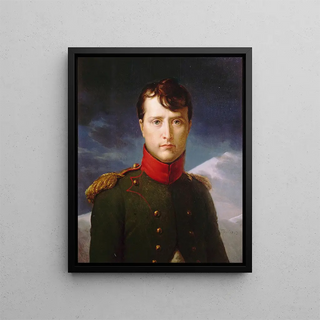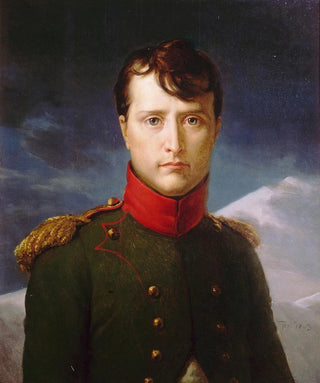Art print | Napoleon Bonaparte First Consul - François Gérard


View from behind

Frame (optional)
Napoleon Bonaparte First Consul Art print by François Gérard – Captivating Introduction
The canvas "Napoleon Bonaparte First Consul" by François Gérard is much more than a simple depiction of a man in power. It embodies an era, an ideal, and an artistic vision that transcend time. This masterpiece, created in the early 19th century, is an ode to the grandeur of Napoleon, a figure whose impact on French and European history is undeniable. Gérard, through his talent, manages to capture not only the physical appearance of the famous general but also the aura that surrounds him. The scene depicts Napoleon in a majestic posture, symbolizing his rise and authority, while also evoking a certain intimacy with the viewer. The power of the work lies in its ability to evoke deep emotions and transport the viewer into the tumultuous universe of the Revolution and the Empire.
Style and uniqueness of the work
François Gérard's style is distinguished by its finesse and attention to detail. In "Napoleon Bonaparte First Consul," he uses rich colors and play of light that emphasize the magnificence of the subject. The drapery of the toga, the texture of the fabrics, and the delicacy of the features are all elements that testify to the artist's skill. Gérard succeeds in blending neoclassicism, with its references to Antiquity, and a romantic approach that gives his work emotional depth. Every element of the composition, from the background to Napoleon's posture, is carefully thought out to reinforce the message of power and legitimacy. The way shadows and lights meet on the consul's face creates an almost mystical atmosphere, inviting the viewer to contemplate the duality of the character: both statesman and warrior.
The artist and his influence
François Gérard, born in 1770, is an emblematic figure of French painting in the early 19th century. A student of Jacques-Louis David, he established himself as a renowned portraitist, capturing the faces of the most influential personalities of his time. His work on Napoleon, in particular, played a crucial role

Matte finish

View from behind

Frame (optional)
Napoleon Bonaparte First Consul Art print by François Gérard – Captivating Introduction
The canvas "Napoleon Bonaparte First Consul" by François Gérard is much more than a simple depiction of a man in power. It embodies an era, an ideal, and an artistic vision that transcend time. This masterpiece, created in the early 19th century, is an ode to the grandeur of Napoleon, a figure whose impact on French and European history is undeniable. Gérard, through his talent, manages to capture not only the physical appearance of the famous general but also the aura that surrounds him. The scene depicts Napoleon in a majestic posture, symbolizing his rise and authority, while also evoking a certain intimacy with the viewer. The power of the work lies in its ability to evoke deep emotions and transport the viewer into the tumultuous universe of the Revolution and the Empire.
Style and uniqueness of the work
François Gérard's style is distinguished by its finesse and attention to detail. In "Napoleon Bonaparte First Consul," he uses rich colors and play of light that emphasize the magnificence of the subject. The drapery of the toga, the texture of the fabrics, and the delicacy of the features are all elements that testify to the artist's skill. Gérard succeeds in blending neoclassicism, with its references to Antiquity, and a romantic approach that gives his work emotional depth. Every element of the composition, from the background to Napoleon's posture, is carefully thought out to reinforce the message of power and legitimacy. The way shadows and lights meet on the consul's face creates an almost mystical atmosphere, inviting the viewer to contemplate the duality of the character: both statesman and warrior.
The artist and his influence
François Gérard, born in 1770, is an emblematic figure of French painting in the early 19th century. A student of Jacques-Louis David, he established himself as a renowned portraitist, capturing the faces of the most influential personalities of his time. His work on Napoleon, in particular, played a crucial role






